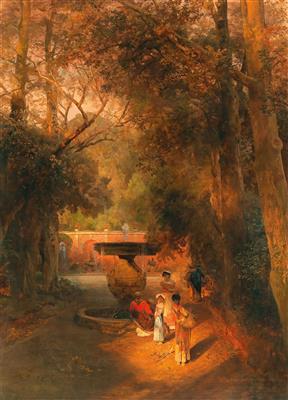Oswald Achenbach

(Düsseldorf 1827–1905)
In the park by the fountain of Villa Torlonia in Frascati, near Rome, signed, dated Osw. Achenbach 1881, oil on canvas, 110 x 81 cm, framed, (Rei)
Counterpart to lot 641
Oswald Achenbach is one of the most important German landscape painters of the 19th century, and is primarily famous for his Italian landscapes. Like his brother Andreas, who was twelve years older than Oswald, he belongs to the Düsseldorf school of painting.
From 1835 onwards, at the tender age of eight, he first took lessons at Düsseldorf’s Academy of Fine Arts. He studied there until 1841. His first trips took him to southern Germany and the Tyrol, and, in 1845, to northern Italy for the first time. In the 1840s, he distanced himself from the academic art scene connected with Düsseldorf’s Academy, and instead engaged with the “Malkasten” association of artists, of which he was a founding member. His first major trip to Italy in 1850 was of particular importance. He travelled to Rome, as well as to the Ligurian coast, and used oil studies to record his impressions of the region surrounding Rome. He was increasingly able to establish himself as an artist in the 1850s and was appointed Professor at Düsseldorf’s Academy of Fine Arts in 1863. The subject of the Italian landscape was always at the heart of his oeuvre. In this regard, his interest particularly lay in the special light visible in Italy and the golden colours that resulted from this. From the 1870s onwards, he travelled time and again to southern Italy and gave up his teaching post at the Academy so he could focus exclusively on painting.
The two lots here form part of Achenbach’s later work, which is distinguished by the fluid application of colour, sometimes in an additive manner.
The present pair of images depict two famous gardens in the Alban Hills, near Rome: the park of the Villa Torlonia in Frascati and the Villa d’Este in Tivoli.
The Villa Frascati was built in the 16th century, with the house and garden being substantially expanded in the baroque period. The property changed hands frequently until 1841, when it was purchased by the Torlonia family. The gardens are particularly well-known for their baroque fountains. In the background of Achenbach’s depiction, too, it is possible to recognise the arcade structure of Carlo Maderno’s water theatre, which was constructed between 1607 and 1625 and represented the core of the gardens. Achenbach has selected a side view, and interweaves the slightly weathered garden architecture with the lush vegetation. He captures the golden light of a late afternoon in summer using his typical warm colour palette.
Specialist: Mag. Dimitra Reimüller
 Mag. Dimitra Reimüller
Mag. Dimitra Reimüller
+43-1-515 60-355
19c.paintings@dorotheum.at
24.10.2018 - 18:00
- Estimate:
-
EUR 20,000.- to EUR 30,000.-
Oswald Achenbach
(Düsseldorf 1827–1905)
In the park by the fountain of Villa Torlonia in Frascati, near Rome, signed, dated Osw. Achenbach 1881, oil on canvas, 110 x 81 cm, framed, (Rei)
Counterpart to lot 641
Oswald Achenbach is one of the most important German landscape painters of the 19th century, and is primarily famous for his Italian landscapes. Like his brother Andreas, who was twelve years older than Oswald, he belongs to the Düsseldorf school of painting.
From 1835 onwards, at the tender age of eight, he first took lessons at Düsseldorf’s Academy of Fine Arts. He studied there until 1841. His first trips took him to southern Germany and the Tyrol, and, in 1845, to northern Italy for the first time. In the 1840s, he distanced himself from the academic art scene connected with Düsseldorf’s Academy, and instead engaged with the “Malkasten” association of artists, of which he was a founding member. His first major trip to Italy in 1850 was of particular importance. He travelled to Rome, as well as to the Ligurian coast, and used oil studies to record his impressions of the region surrounding Rome. He was increasingly able to establish himself as an artist in the 1850s and was appointed Professor at Düsseldorf’s Academy of Fine Arts in 1863. The subject of the Italian landscape was always at the heart of his oeuvre. In this regard, his interest particularly lay in the special light visible in Italy and the golden colours that resulted from this. From the 1870s onwards, he travelled time and again to southern Italy and gave up his teaching post at the Academy so he could focus exclusively on painting.
The two lots here form part of Achenbach’s later work, which is distinguished by the fluid application of colour, sometimes in an additive manner.
The present pair of images depict two famous gardens in the Alban Hills, near Rome: the park of the Villa Torlonia in Frascati and the Villa d’Este in Tivoli.
The Villa Frascati was built in the 16th century, with the house and garden being substantially expanded in the baroque period. The property changed hands frequently until 1841, when it was purchased by the Torlonia family. The gardens are particularly well-known for their baroque fountains. In the background of Achenbach’s depiction, too, it is possible to recognise the arcade structure of Carlo Maderno’s water theatre, which was constructed between 1607 and 1625 and represented the core of the gardens. Achenbach has selected a side view, and interweaves the slightly weathered garden architecture with the lush vegetation. He captures the golden light of a late afternoon in summer using his typical warm colour palette.
Specialist: Mag. Dimitra Reimüller
 Mag. Dimitra Reimüller
Mag. Dimitra Reimüller
+43-1-515 60-355
19c.paintings@dorotheum.at
|
Buyers hotline
Mon.-Fri.: 10.00am - 5.00pm
kundendienst@dorotheum.at +43 1 515 60 200 |
| Auction: | 19th Century Paintings |
| Auction type: | Saleroom auction |
| Date: | 24.10.2018 - 18:00 |
| Location: | Vienna | Palais Dorotheum |
| Exhibition: | 13.10. - 24.10.2018 |
